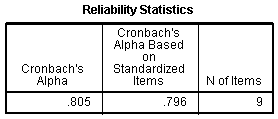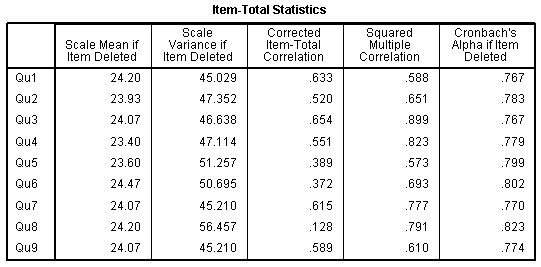Cronbach's Alphas
What does Cronbach's alpha mean?
Cronbach's alpha is a measure of internal consistency, that is, how closely related a set of items are as a group. It is considered to be a measure of scale reliability.Cronbach's alpha is the most common measure of internal consistency ("reliability"). It is most commonly used when you have multiple Likert questions in a survey/questionnaire that form a scale and you wish to determine if the scale is reliable. If you are concerned with inter-rater reliability, we also have a guide on using Cohen's (κ) kappa that you might find useful.
SPSS Output for Cronbach's Alpha
SPSS produces many different tables. The first important table is the Reliability Statistics table that provides the actual value for Cronbach's alpha, as shown below:

Published with written permission from SPSS, IBM Corporation.
From our example, we can see that Cronbach's alpha is 0.805, which indicates a high level of internal consistency for our scale with this specific sample.
Item-Total Statistics
The Item-Total Statistics table presents the "Cronbach's Alpha if Item Deleted" in the final column, as shown below:

Published with written permission from SPSS, IBM Corporation.
This column presents the value that Cronbach's alpha would be if that particular item was deleted from the scale. We can see that removal of any question, except question 8, would result in a lower Cronbach's alpha. Therefore, we would not want to remove these questions. Removal of question 8 would lead to a small improvement in Cronbach's alpha, and we can also see that the "Corrected Item-Total Correlation" value was low (0.128) for this item. This might lead us to consider whether we should remove this item.
In the paper, this is the right way to explain about the cronbach alpha
measurement items. Table 5 summarizes the loadings and alpha values. As seen
from Table 5, all alpha values are above 0.6 as suggested by Nunnally and Berstein
(1994).
No comments:
Post a Comment